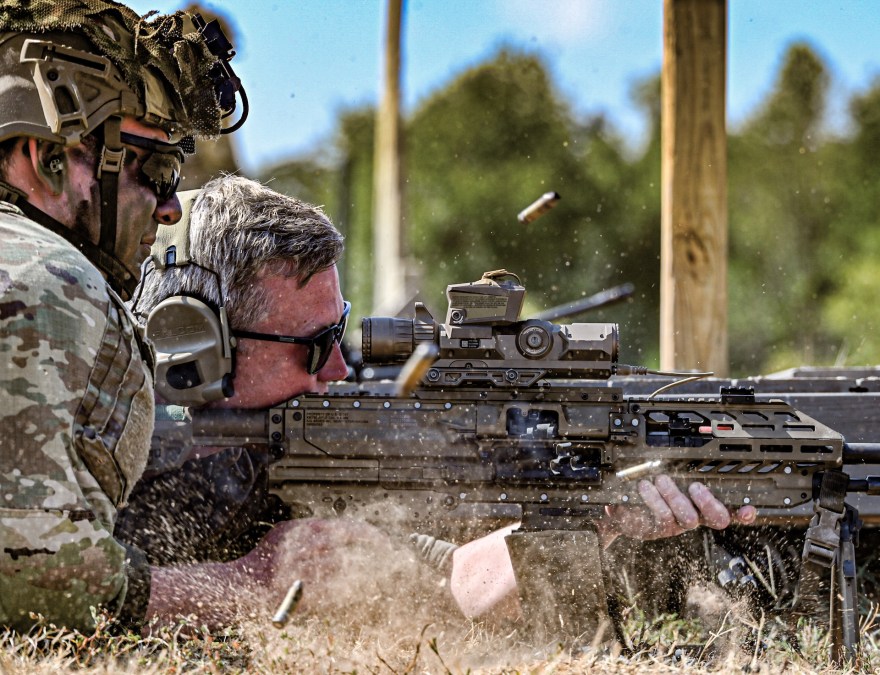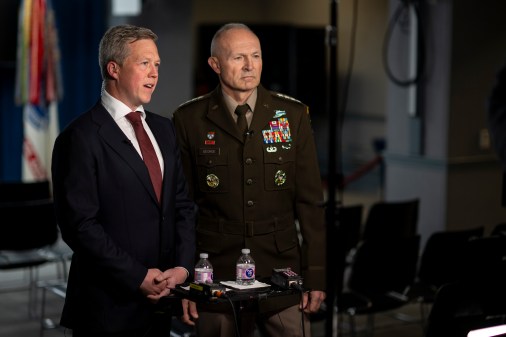Driscoll teases major Army acquisition reorganization in fiery speech at AUSA

In a fiery keynote address Monday morning at the annual AUSA conference, Army Secretary Dan Driscoll promised major reforms in how the service acquires and maintains its technology.
Driscoll, the Army’s top civilian official, depicted a force plagued with inefficient bureaucracy and old systems.
“We cannot fucking wait to innovate until Americans are dying on the battlefield. We must act now to enable our soldiers. Our window to change is right now, and we have a plan to do it. We will set the pace of innovation, and we will win with silicon and silicone and software, and not our soldiers’ blood and bodies,” he said.
The Army has wasted billions of dollars on failed programs in recent decades, while failing to keep up with advances in the private sector, the former soldier noted.
“The commercial sector transformed the world [in areas like] AI, robotics, ubiquitous computing, but our soldiers are still stuck fighting with systems conceived in the 1980s. When I was in Iraq in 2009, the gap between military and commercial technology was stunning. Returning to the Army 15 years later, I am absolutely enraged — enraged to report that the gap has grown to a deep chasm, and our soldiers have to cross that chasm every single day,” Driscoll said, adding that troops are equipped with “obsolete” capabilities.
Army leadership is taking steps to address the problems highlighted by the secretary.
Driscoll previewed an upcoming announcement about a major reform in the organizational construct of the Army’s acquisition enterprise.
“Traditionally, program executive officers manage a group of Army acquisitions programs that deliver capabilities to soldiers. For decades, our PEOs trusted a process-oriented acquisition cycle that was really good at slow, expensive and suboptimal outcomes. Process-oriented systems are over-complicated, over-regulated, and overdue for reform,” Driscoll said. “The traditional 12- to 18-month contracting cycle is just no longer feasible. Tech advancement moves too fast for multiyear acquisitions.”
In the coming weeks, the service will announce changes to how the Army buys military equipment, according to the secretary.
“Our acquisitions enterprise is more complicated than it should be, and that’s getting in the way of empowering soldiers. So, we will combine it all under a single organization that reports directly to senior Army leadership. We want fast and efficient. We want to get soldiers the tools they need now, not a decade in the future. We will break down barriers until we measure acquisitions not in years and billions [of dollars], but in months and thousands” of dollars, he said.
Earlier this year, Driscoll and Chief of Staff Gen. Randy George announced a transformation initiative aimed at getting rid of obsolete systems and leveraging dual-use capabilities.
The service recently announced another effort, dubbed FUZE, which Driscoll described at the AUSA conference as the Army’s “new cradle to grave capital funding model.”
“It will identify promising startups quickly fund them and get minimally viable products to soldiers in weeks. FUZE, like VC firms, will be successful because we will work with agile, innovative, hungry startups that live on the very edge of innovation,” said.
Driscoll suggested that his previous experience in the private sector has shaped his views of how the Army should move forward with modernization.
“I used to be in the Army, became a lawyer, worked in investment banking, venture capital, and now I’m back in the army. I did a full circle. After seeing the power of combining venture capital, money and mentorship with startup culture, I can say unequivocally that the Silicon Valley approach is absolutely ideal for the Army,” he said.
The Army has already aligned $750 million to this model under FUZE. Next year, it plans to boost that to $765 million next year.
As part of that initiative, AUSA will feature a new competition called xTechDisrupt — which Driscoll likened to a Shark Tank-like effort — where companies will make a pitch for $500,000. If selected, they’ll “sprint” for 30 days to launch “breakthrough” tech. From there, they will take it to the field and iterate with soldiers for another month to improve their product, Driscoll explained.
“Our goal with FUZE is to contract with startups that have never, ever worked with the United States Army before in just 60 to 70 days. For companies we have worked with that have prototype-level entries, we want to contract in 10 and start soldier iterations in 30 to 45 days. We train like we fight. Acquisition should be no different. We wouldn’t take 10 to 12 months to sign a contract while in a fight. So, we will train our system to move fast. And soon, Ukraine won’t be the only Silicon Valley of warfare. FUZE finds and grows capabilities and then feeds them into our broader acquisition system,” he said.
Driscoll noted that he and Secretary of the Treasury Scott Bessent plan to meet with industry partners at AUSA with the goal of augmenting Army resources through private investment.
After the Army acquires tech, it needs to have the “right to repair” and be able to leverage additive manufacturing capabilities to 3D print parts, Driscoll noted, adding that the service is losing time and money under the current system.
“We sign away our right to repair. We pay unbelievable cost markups and can wait years for parts we could 3D print ourselves immediately. This may sound trivial, but simply being able to make or repair our own parts can save millions of dollars and save lives and ensure that million-dollar pieces of equipment … don’t sit idle waiting for parts,” he said.
Driscoll’s vision is to accelerate advanced manufacturing across the entire Army.
“Once we have the schematics, private industry can help surge production if demand surpasses what the Army can produce itself. For certain parts, soldiers will be able to download the schematics, manufacture it and install it all in the field. This is about more than money. This is an issue that is undermining our national security. It is imperative that we have a right to repair, and we need modular open architecture systems where repairs are as easy as printing a part or buying one off the shelf,” he said.






